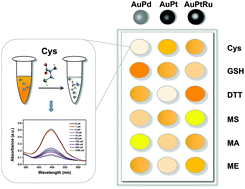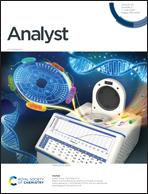Gold alloy-based nanozyme sensor arrays for biothiol detection†
Abstract
Biothiols play an important role in living cells and are associated with many diseases. Thus, it is necessary to develop a facile, cost-effective, and convenient analytical method for the detection of biothiols. Nanozymes are functional nanomaterials with enzymatic activities. Due to their unique advantages (e.g., low cost, high stability, and multifunctionality), nanozymes have been extensively used to construct sensing systems. Previous studies demonstrated colorimetric assays for biothiol detection because they could competitively inhibit the peroxidase-like activities of nanozymes. However, few studies were able to differentiate biothiols from each other. To address these challenges, herein, we first synthesized Au alloy nanozymes with better peroxidase-like activities than gold nanoparticles (AuNPs). Then, cross-reactive sensor arrays were constructed with three alloy nanozymes. Six typical biothiols (i.e., glutathione, cysteine, dithiothreitol, mercaptoacetic acid, mercaptoethanol, and mercaptosuccinic acid) were successfully detected and discriminated by the as-prepared nanozyme sensor arrays. Moreover, the practical application of the nanozyme sensor arrays was demonstrated by discriminating biothiols in serum successfully.



 Please wait while we load your content...
Please wait while we load your content...